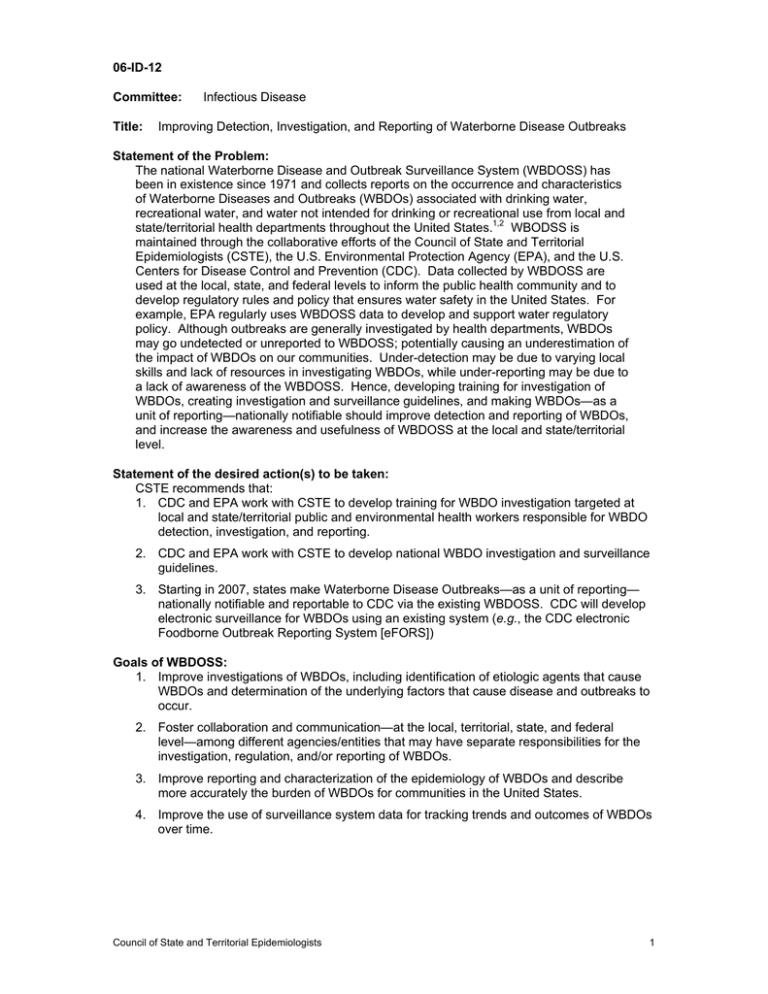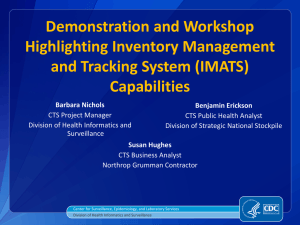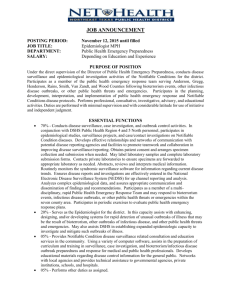06-ID-12 Committee: Title: Statement of the Problem:
advertisement

06-ID-12 Committee: Title: Infectious Disease Improving Detection, Investigation, and Reporting of Waterborne Disease Outbreaks Statement of the Problem: The national Waterborne Disease and Outbreak Surveillance System (WBDOSS) has been in existence since 1971 and collects reports on the occurrence and characteristics of Waterborne Diseases and Outbreaks (WBDOs) associated with drinking water, recreational water, and water not intended for drinking or recreational use from local and state/territorial health departments throughout the United States.1,2 WBODSS is maintained through the collaborative efforts of the Council of State and Territorial Epidemiologists (CSTE), the U.S. Environmental Protection Agency (EPA), and the U.S. Centers for Disease Control and Prevention (CDC). Data collected by WBDOSS are used at the local, state, and federal levels to inform the public health community and to develop regulatory rules and policy that ensures water safety in the United States. For example, EPA regularly uses WBDOSS data to develop and support water regulatory policy. Although outbreaks are generally investigated by health departments, WBDOs may go undetected or unreported to WBDOSS; potentially causing an underestimation of the impact of WBDOs on our communities. Under-detection may be due to varying local skills and lack of resources in investigating WBDOs, while under-reporting may be due to a lack of awareness of the WBDOSS. Hence, developing training for investigation of WBDOs, creating investigation and surveillance guidelines, and making WBDOs—as a unit of reporting—nationally notifiable should improve detection and reporting of WBDOs, and increase the awareness and usefulness of WBDOSS at the local and state/territorial level. Statement of the desired action(s) to be taken: CSTE recommends that: 1. CDC and EPA work with CSTE to develop training for WBDO investigation targeted at local and state/territorial public and environmental health workers responsible for WBDO detection, investigation, and reporting. 2. CDC and EPA work with CSTE to develop national WBDO investigation and surveillance guidelines. 3. Starting in 2007, states make Waterborne Disease Outbreaks—as a unit of reporting— nationally notifiable and reportable to CDC via the existing WBDOSS. CDC will develop electronic surveillance for WBDOs using an existing system (e.g., the CDC electronic Foodborne Outbreak Reporting System [eFORS]) Goals of WBDOSS: 1. Improve investigations of WBDOs, including identification of etiologic agents that cause WBDOs and determination of the underlying factors that cause disease and outbreaks to occur. 2. Foster collaboration and communication—at the local, territorial, state, and federal level—among different agencies/entities that may have separate responsibilities for the investigation, regulation, and/or reporting of WBDOs. 3. Improve reporting and characterization of the epidemiology of WBDOs and describe more accurately the burden of WBDOs for communities in the United States. 4. Improve the use of surveillance system data for tracking trends and outcomes of WBDOs over time. Council of State and Territorial Epidemiologists 1 Methods for Surveillance: Public health departments from localities and states/territories have the primary responsibility for detecting, investigating, and reporting WBDOs to WBDOSS, a system managed by the CDC, Division of Parasitic Diseases. Selected information collected by public health departments during the course of WBDO investigations will be reported to WBDOSS using a standard report form. CDC solicits data on characteristics of the outbreak, including person, place, time, and location information; results from epidemiologic studies conducted; clinical specimen and water sample testing; and other factors potentially contributing to the outbreak (e.g., environmental concerns, disinfection, and filtration). CDC annually requests reports from local, territorial, and state epidemiologists or persons designated as WBDO surveillance coordinators. Period of Surveillance: Continuous surveillance. No end date. Background and Justification: WBDOs occur infrequently, but have the capacity to cause a great deal of morbidity and mortality when they occur. 3 WBDO surveillance is an important activity that allows health departments to detect and respond to outbreaks, and identify areas where preventive measures can be most effective. However, as with most surveillance systems, it is generally accepted that WBDO surveillance is incomplete, and estimates suggest that 67-90% of WBDOs go undetected or unreported.4 Although most states (~90%) require all “outbreaks” to be reported in their reportable disease list, many (~68%) do not include any specific reference to waterborne outbreaks or waterborne disease.5 The lack of uniformity in WBDO detection, investigation, and reporting demonstrates a great need for increased training targeted at local and state/territorial health department investigators, and national guidelines that outline investigation methodology and surveillance requirements. Under-detection and under-reporting affects the sensitivity of local, state/territorial, and national surveillance systems, and diminishes the capability of public health officials to make informed decisions in response to the estimated impact of WBDOs on our communities. WBDOSS is a voluntary paper-based system that tracks outbreaks due to exposure from drinking water systems, recreational-water venues, and other water sources. This surveillance system is unique because it collects reports on the occurrences and characteristics of outbreaks—as the unit of reporting—rather than individual cases. Health departments are responsible for the detection and investigation of WBDOs, and reporting them to WBDOSS. Although encouraged to report investigation results as they occur, state and territorial health departments are solicited each September by CDC to submit information regarding all WBDOs for that year. The information transmitted to WBDOSS is then used to assess trends at the state and national level and findings are published biennially in the CDC-Morbidity and Mortality Weekly Report (MMWR) Surveillance Summaries. Presently, plans are underway to add electronic reporting of WBDOs through eFORS. Experience indicates that enhancing existing WBDO surveillance systems improves the detection and reporting of WBDOs.6, 7 Providing WBDO-specific investigative training and strengthening communication between different health department strata (i.e., state-local, epidemiology-environmental health) and among the various agencies responsible for investigation and reporting has been shown to increase the number of outbreaks recognized and investigated.7 Although implementing such activities is likely to improve surveillance at the local and state/territorial level, national guidelines that could be used to model training programs and provide the basis for uniform reporting do not yet exist, and CDC has noted several occasions where WBDOs were not reported to WBDOSS. These deficits are concerning as non-uniform reporting to WBDOSS can affect state/territorial and national estimates for the burden of WBDOs and obscure important trends that can motivate critical Council of State and Territorial Epidemiologists 2 preventive measures. To address these concerns, the development of national guidelines will provide the framework through which WBDO-specific investigative training and improved communication networks can be developed. In addition, enhancing local surveillance and making WBDOs nationally reportable should increase the awareness of WBDOSS—and its reporting requirements—among local and state/territorial health departments, and improve reporting to this system. Coordination: Agencies for Response: (1) Julie L. Gerberding, MD, MPH. Director Centers for Disease Control and Prevention Office of the Director 1600 Clifton Road, Mailstop D14 Atlanta, Georgia, 30333 Telephone: (404) 639-7000 Fax: (404) 639-7111 E-mail: jyg2@cdc.gov (2) Stephen L. Johnson, Administrator US Environmental Protection Agency Ariel Rios Building Mail Code: 1101ª Washington, DC 20460 Telephone: (202) 564-4700 Fax: (202) 501-1450 E-mail: johnson.stephen@epa.gov Agencies for Information: (1) Rebecca L. Calderon, MPH, PhD, Director Human Studies Division National Health & Environmental Effects Research Laboratory US EPA MD-58a Research Triangle Park, NC 27711 Tel: 919-966-9584 Fax: 919-966-6212 E-mail: calderon.rebecca@epa.gov Submitting Author: (1) Duc J. Vugia, MD, MPH. Chief, Infectious Diseases Branch California Department of Health Services 850 Marina Bay Parkway, Building P 2nd Floor Richmond, CA 94804 Tel: 510 620-3434 Fax: 510 620-3425 E-mail: dvugia@dhs.ca.gov Co-Authors: (1) D. Fermín Argüello II, MD, MPH. Preventive Medicine Resident Centers for Disease Control and Prevention Division of Parasitic Diseases 4770 Buford Highway, N.E., Mailstop F-22 Atlanta, GA 30341-3724 Council of State and Territorial Epidemiologists 3 Tel: 770 488-3602 Fax: 770 488-7761 E-mail: dla7@cdc.gov (2) Michael Beach, PhD. Team Leader, Water and Environment Activity Centers for Disease Control and Prevention Division of Parasitic Diseases 4770 Buford Highway, N.E., Mailstop F-22 Atlanta, GA 30341-3724 Tel: 770 488-7763 Fax: 770 488-7761 E-mail: mjb3@cdc.gov (3) Rebecca L. Calderon, MPH, PhD, Director Human Studies Division National Health & Environmental Effects Research Laboratory US EPA MD-58a Research Triangle Park, NC 27711 Tel: 919-966-9584 Fax: 919-966-6212 E-mail: calderon.rebecca@epa.gov Council of State and Territorial Epidemiologists 4 References: 1. CDC. Surveillance for Waterborne-Disease Outbreaks Associated with Recreational Water— United States, 2001-2002. MMWR Oct 22, 2004;53(SS-8); 1-22. (PDF version of this article can be accessed via the internet at: http://www.cdc.gov/mmwr/PDF/ss/ss5308.pdf ) 2. CDC. Surveillance for Waterborne-Disease Outbreaks Associated with Drinking Water— United States, 2001-2002. MMWR Oct 22, 2004;53(SS-8); 23-45. (PDF version of this article can be accessed via the internet at: http://www.cdc.gov/mmwr/PDF/ss/ss5308.pdf) 3. MacKenzie WR, Schell WL, Blair KA, Addiss DG, Peterson DE, Hoxie NJ, Kazmierczak JJ, Davis JP. A Massive Outbreak in Milwaukee of Cryptosporidium Infection Transmitted through the Public Water Supply. New England Journal of Medicine 1994;331(3):161-167. 4. Frost FJ, Calderon RL. Waterborne Disease Surveillance: Findings of a Survey of State and Territorial Epidemiology Programs. Journal of Environmental Health 1995: 58(5):6-9. 5. Figures derived from a review of the most recent available on-line state notifiable disease lists (N=49). 6. Harter L, Frost F, Vogt R, Little AA, Hopkins R, Gaspard B, Lippy EC. A Three-State Study of Waterborne Disease Surveillance Techniques. American Journal of Public Health 1985;75(11):1327-8. 7. Hopkins RS, Shillam P, Gaspard B, Eisnach L, Karline RJ. Waterborne Disease in Colorado: Three Years’ Surveillance and 18 Outbreaks. American Journal of Public Health 1985;75(3):254-57. Council of State and Territorial Epidemiologists 5



